Scratch Astrox Icarus Original Design / Scratch Built
Scratch - Astrox Icarus {Scratch}
Contributed by Duane Boldt
| Manufacturer: | Scratch |
(Contributed - by Duane Boldt - 10/27/09)
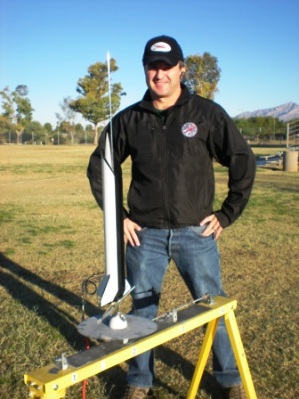
Rocket Name: Astrox Icarus
Rocket Height: 24 1/8 inches and Width: 9 inches and Weight: 7.1 ounces (10.2 with motors)
Motor Mount: 1st Stage: 24mm 2nd Stage: 24mm
Recovery System: 1st Stage: Tumble 2nd Stage: 18” Nylon Parachute
Scratch built, staged, 24mm, tumble, parachute
Motors: Single Stage: D12-3 (flown), D12-5, Two Stage: D12-0 (Booster) C11-3, D12-3 (Upper Stage)
Components:
- 1 – BT80 body tube – 19 3/8 inches
- 1 – BT80 body tube – 3 ½ inches
- 1 – BT55 body tube – 16 3/8 inches
- 1 – BT55 body tube – 3 ½ inches
- 2 – Motor tubes – 24mm x 3 ½ inches
- 2 – 24mm thrust rings
- 4 – BT55/24mm motor mount centering rings
- 2 – 2 inch x 3/16 inch launch lugs
- 2 – 3 inch x ¼ inch launch lugs
- 2 – 3 inch x ¼ inch wood dowels
- 4 – Balsa wood booster fins
- 2 – Balsa wood sustainer fins
- 1 – Balsa wood sustainer tail fin
- 1 – Kevlar shock cord (attaches to motor mount)
- 1 – Elastic shock cord (attaches to Kevlar cord and nose cone)
- 1 – 18 inch nylon rip-stop parachute
- 1 – BT55 nose cone
Construction/Finishing:
The hardest part to building the Astrox “Icarus” is measuring marking and cutting the heavy duty BT80 body tube. Measuring the pictures provided in the EMRR “Design this Spaceship” contest for the Astrox vehicle, I roughly translated to the dimensions I would need when building the hollow main body out of BT80.
This model was to be capable of 2 stage flights, so the first part I planned and built were the motor mounts. The
motor mounts use a common configuration of staged black powder motors. The thrust ring on the lower stage is mounted
below the 1st stage motor. This provides for the ejection charge of that stage to burn through the tape and blast
off the booster. The booster will then tumble back for recovery.
The upper stage motor has its thrust ring mounted to the forward end to allow the thrust of both motors to push the
rocket upwards. Kevlar cord is tied around the forward end of the upper stage motor mount and then secured using
the forward centering ring glued into place.

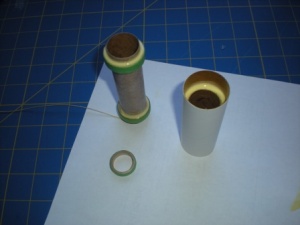
Masking tape is used for retaining both motors.
Booster:
This booster stage was designed to match and complement the Astrox air breathing rocket concept vehicle model design.
The booster motor mount is glued inside the 3 ½ inch BT55 body tube, flush with the bottom end.
After the booster motor mount is dry, an angle guide was used to draw straight lines on the outside of one side of
the BT55 tube. I drew another straight line inside the 3 ½ inch BT80 body tube. Then the booster motor assembly
was glued inside the BT80 tube with the two lines touching. After drying, fillets were added to both sides. Then the
body tube was marked for 4 fins using an Estes tube marking guide. The four booster fins were glued to this and fillets
were applied.
Stage Connecting Dowels
The taped motors provide most of the stability between the stages, but ¼ inch dowels and launch lugs were added to keep the stages from twisting around the motors during flight and becoming unstable. The two 3 inch x ¼ inch launch lugs are cut into four 1 ½ inch lengths. Two of these launch lug pieces are glued alongside the motor mount inside the booster BT80 body tube. They are glued flush with the top end. When the lugs were dry, the ¼ inch wood dowels was glued into them with 1 ½ inches sticking out upwards.
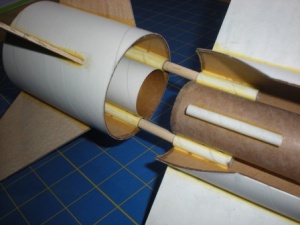

That completes construction of the booster stage.
Upper Stage:
The upper stage motor mount is glued inside the longer BT55 body tube flush with the bottom making sure not to get glue on the Kevlar shock cord. This is set aside to dry.
The longer BT80 body tube is marked with the Estes tube marking guide for four fins. Fin lines are extended the length of the tube using the marking tool. Two more lines are marked 1 inch on either side of one of the fin lines and extended using the marking tool. These two lines are then cut carefully with a hobby knife and straight edge. Once this 2 inch “slot” is cut out of the BT80 body tube, the angled rear cuts are made and then the more complicated curved cut in the front is measured marked and cut. After are the cuts were made the edges were smoothed out with fine sandpaper and thin CA was applied to all the cut edges prevent them from coming apart.
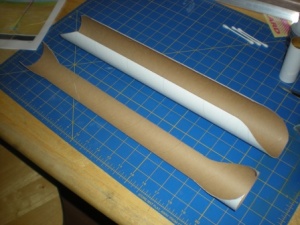

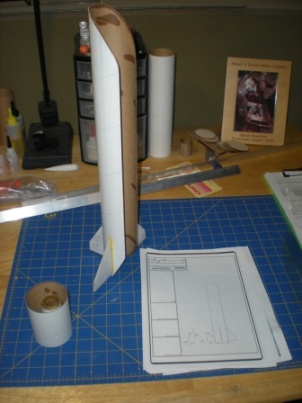
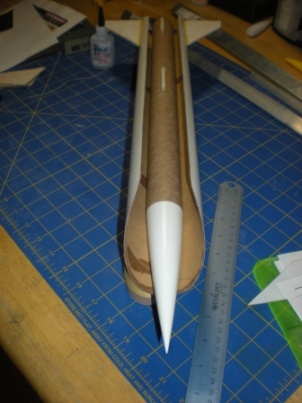
Next a line is drawn with a straight edge inside the BT80 tube opposite the tail fin line on the outside. Using a marking tool, two lines are drawn on opposite sides of the longer BT55 body tube. The two 3/16” launch lugs are glued onto one of the lines on the BT55 tube. One is glued 3/8 inch from the motor mount end and the other is glued at 7 inch from that same end. Those are let to dry then fillets are applied.
A line of glue is put on the other line on the BT55 tube. Then BT55 tube is now glued inside the BT80 tube lining up the marks on both tubes. After this dries then fillets are applied to both sides of the BT55 tube, taking care not to get glue inside the nose cone end. Once the fillets are dry, the remaining two 1 ½ inch pieces of ¼ inch launch lug are glued along side the BT55 tube flush with the bottom. Fillets are applied to both of these.
The upper stage fins and tail fin are glued onto their respective fin lines 3/8 inch from the rear end. After they are dry, fillets are applied. (Because the fin grain direction wasn’t ideal in the pieces of balsa I used for these fins, I applied paper “skins” to these three fins to strengthen then before mounting.)

Recovery system:
Once the upper stage glue is dry, the elastic shock cord can be tied to the Kevlar cord and then to the nose cone. The 12 inch parachute is then attached to the nose cone.
Painting, Masking and Painting Again:
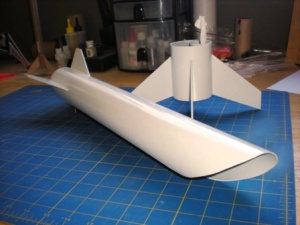
The whole model was painted with gray primer. Once the primer was dry it was painted with gloss white paint. Not much was sprayed inside the BT80 tube as these would later be painted black. The white paint was allowed to dry for 16 hours. (This should have been 24 hours or more, but I was trying to meet the deadline for the EMRR contest…)
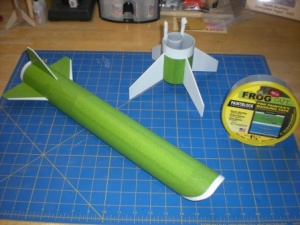
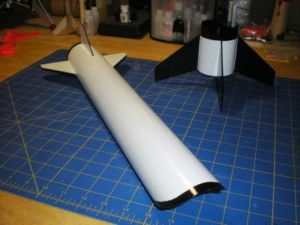
The areas on both the booster and upper stage that were to remain white were masked off using high quality green “Frog Tape.” Then gloss black paint was used to paint everything that was not masked.

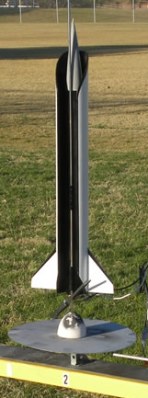



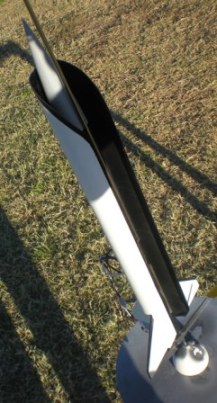
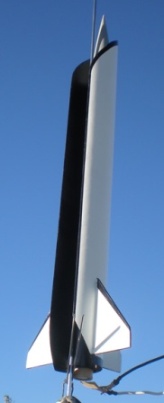
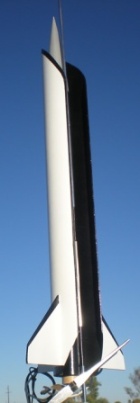
Flight(s)
1st Flight: Estes D12-3, Wind 5-10 mpg
Flight took off nice and straight but then arched over and flipped. We will try adjusting for stability issues.
We and try to fly in zero wind next time. Tail fin was broken off on impact with ground, but easily repaired.
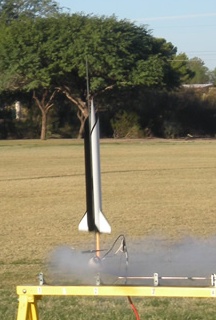


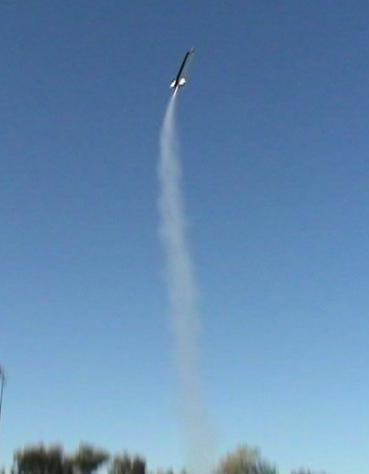
Next Steps:
The longer BT55 nose cone we used will be painted gloss white. We decided that would look cool contrasting the gloss black interior. We recessed the BT55 body tube enough that we can use an optional shorter BT55 nose cone painted gloss black to pretty much hide it when flying and taking pictures. We will work out the stability issues and launch again. We are also in the process of completing decals for the NASA logos and American flags.
Sponsored Ads
 |
 |











